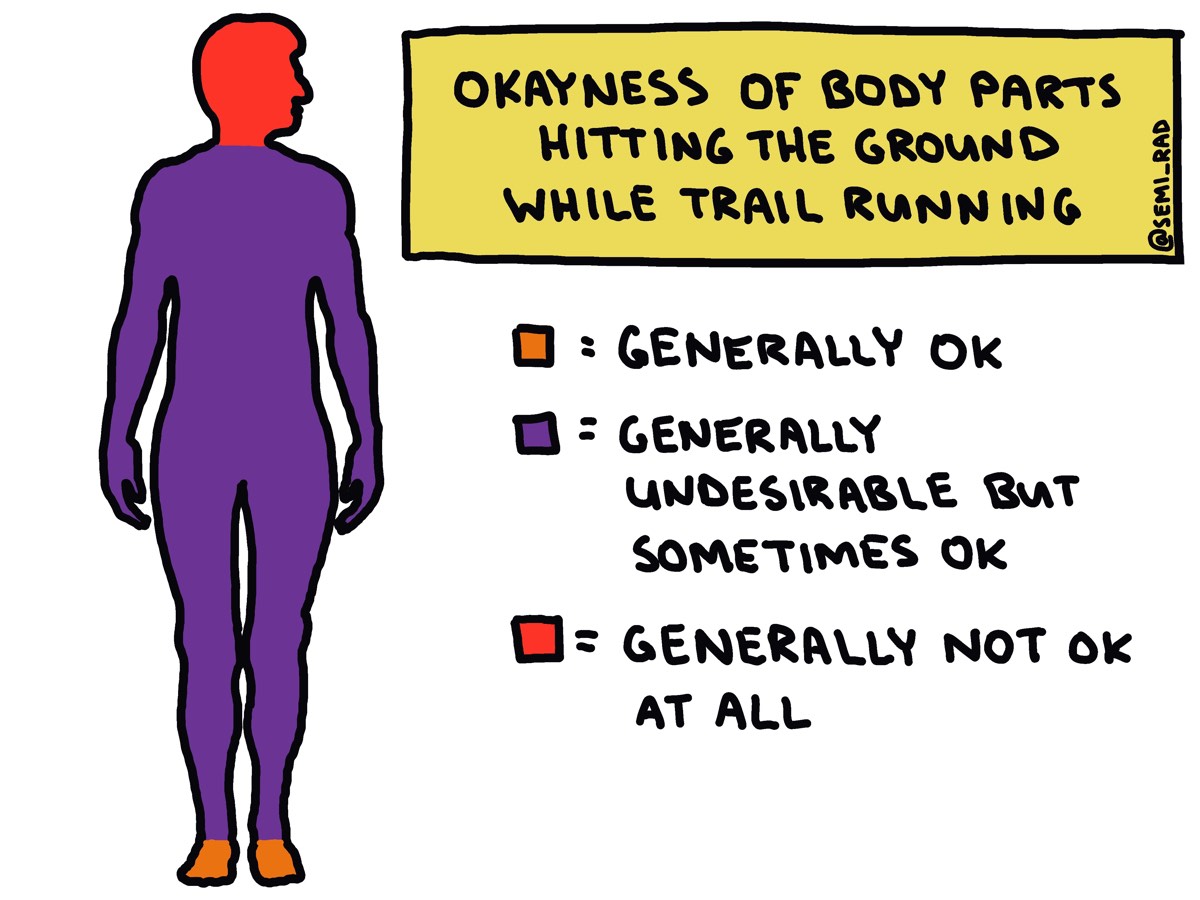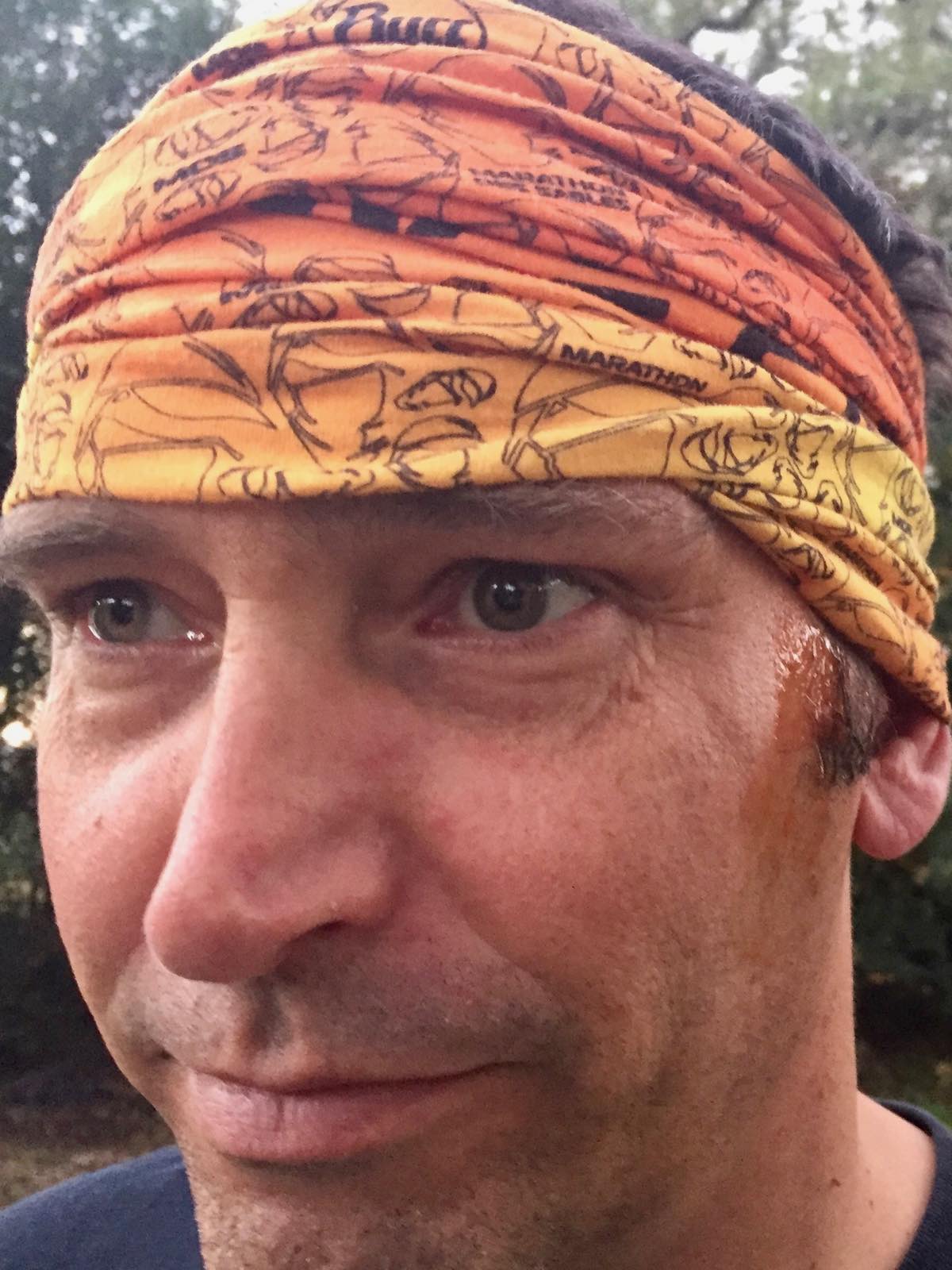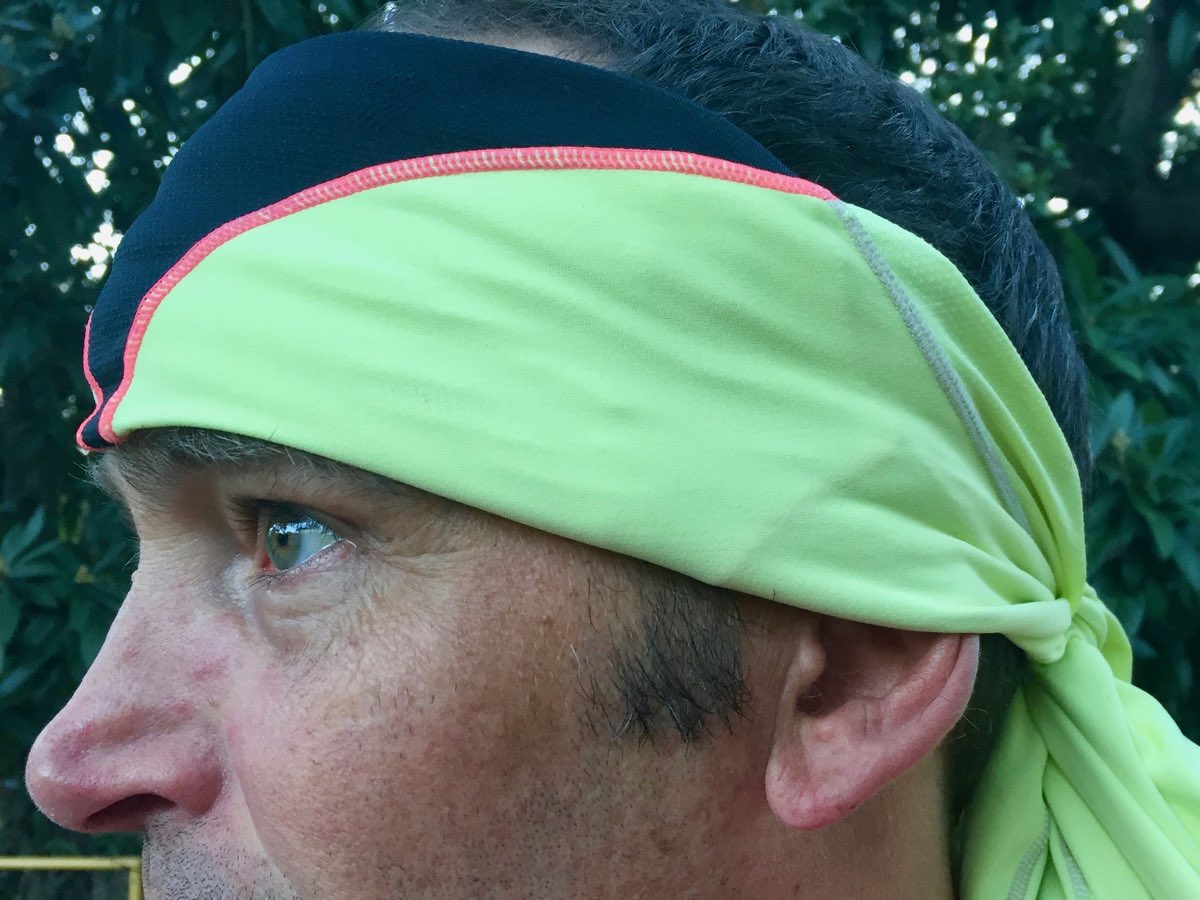Scenario:
You’re running the Uwharrie 100 Mile in North Carolina. Their motto is, “Simply Unrelenting,” and it’s pretty spot on. So many rocks and roots! But you’ve made it to the third 20.5-mile loop, and despite a fall on “The Soul Crusher” hill that left your knees Halloween ready, you’re feeling good. It’s dark now and the rocks are slippery from the rain that’s been falling on and off throughout the day. You’re starting up “Hallucination Hill” when you hear a yell. It’s not far ahead of you and in less than a minute your headlamp illuminates a runner sitting on trail holding the side of her head.

Image: Semi-Rad/Brendan Leonard
“Are you okay? What happened?” you ask.
“I slipped. I was trying to open a gel and I slipped. I couldn’t get my hands out fast enough, and I just went face first into those rocks. It’s really bleeding.”
She moves her hand. There’s blood on the side of her face and an ugly-looking cut on her right temple.
“I just need to sit here for a mi…” She turns and vomits on the ground.
“Oh, my head really hurts. I’ll be okay. I’ll be okay.”
She stands up and sways.
“Oh, man, I’m lightheaded,” she says and sits back down. “I’ll really be fine. I just need to sit here for a minute. Go on ahead.”
You’re about two miles from an aid station.
You should:
A. Take her at her word and go on ahead
B. Ask her to stay put while you run to the aid station for help
C. Walk with her to the next aid station
D. Call 911
Choose an answer before continuing.
Answer:
A. Walk with her to the next aid station
Headache, dizziness, and isolated vomiting are signs of a mild head injury, also called a concussion. This runner needs to be evaluated by a medical professional before continuing. Anyone who hits their head and tells you they feel any of the following should see someone trained to evaluate head injuries.
- A brief change in level of consciousness (They blacked out.)
- Temporarily blurred vision or ‘seeing stars’
- Nausea, isolated vomiting
- Headache, dizziness, feeling really tired
- Personality changes, emotional changes
- Memory problems
If the trauma is enough to cause these symptoms, there’s a possibility the brain could start to swell. And nothing good happens when the brain swells. (Think: unconsciousness, seizures, death.) So even though the symptoms seem pretty mild in this scenario, and we’ve all heard stories of people hitting their heads during races and soldiering on despite (what you now know are) symptoms of mild head injuries, this runner shouldn’t keep racing. She needs to get evaluated. And because she’s lightheaded, you should accompany her to the aid station so she doesn’t fall again.
If she can’t walk due to her lightheadedness, and you can’t call for help, it’d make sense to leave her to get help. If you have phone reception, calling the number the race has identified for emergencies will get you help much more quickly than calling 911. The Uwharrie race director actually puts this number on the back of every racer’s bib (along with an inspirational message!)
The scenario continues:
You tell the runner, CJ, you’d like to walk with her until the next aid station. She accepts the help. The cut is still bleeding a bit when she takes her hand off it. What can you do to stop the bleeding from her scalp while you’re walking to the aid station? Think of what you commonly carry with you during a race. Maybe you came up with something like this?
Or this?
The scenario continues:
You make it to the Crossroads aid station at 3 a.m. and tell the volunteers what happened. They compliment you on your bandaging and tell CJ it’ll probably take about an hour to get a car down a dirt road near the aid station. From there, it’ll only be a 40-minute drive to the hospital. CJ asks if she can lie down and nap while they’re waiting.
Is it okay for someone with a head injury to sleep?
A. Yes
B. No!
Choose an answer before continuing.
Answer:
A. Yes
It’s just fine. Sleep does not make anything worse. (I know. I know! Despite the myth we’ve all heard, this is safe. Keep reading.) But it’s very important you check on the injured person every few hours to make sure their brain isn’t swelling. How would you know their brain was swelling? Their symptoms would be worse. Worse headache. Worse lightheadedness. Exorcist-style vomiting. Or trouble walking. They might be confused or disoriented. They might have a seizure. It would be quite clear to you that things were getting worse. And sleep didn’t cause any of that to happen. (If it did, we’d all be in for an interesting night tonight.) The reason you were once told not to let someone with a head injury go to sleep is because that’s easier advice than, “If there’s a delay in getting someone to a clinic or hospital, it’s fine to let them sleep if you wake them up every few hours and make sure their symptoms aren’t getting worse. And if they are, get them to the hospital quickly.”
All that said, because vomiting is so common with a head injury, it’s best if CJ rests on her side. That way, if she vomits again, it’ll go onto the ground and not into her lungs.
The scenario continues:
CJ naps while the volunteers notify the race director and make arrangements for the car to meet them. They drive her to the emergency room and the doctor there orders a CT scan. They observe her for the next few hours and then release her. She heads right to the finish line to cheer runners as they finish. She’ll be back next year for that belt buckle.
[Author’s Note: Learn more about caring for head injuries in the field and other wilderness first-aid skills with a two-day NOLS course. Thank you to Tod Schimelpfenig, NOLS Wilderness Medicine’s Curriculum Director and author of NOLS Wilderness Medicine, for his guidance and oversight of this series. Thanks also to graphic artist Brendan Leonard, the trail and ultrarunner of Semi-Rad fame, for his graphics collaboration in this article series.]
Call for Comments
Have you ever had a mild head injury while trail running? How did it happen? What were your symptoms? What did you do?


